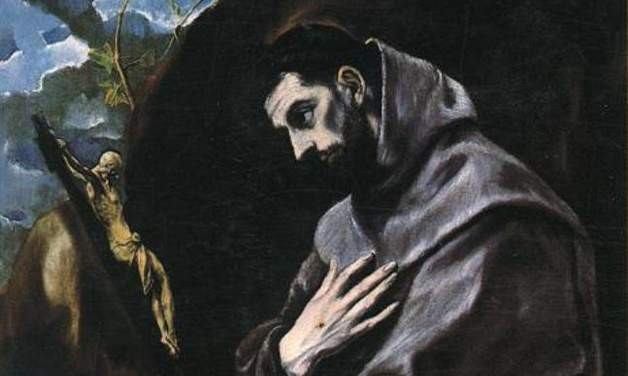That providence which steers the universe
with such a plan that all created sight
is overcome before it plumbs the depths,
To lead unto her Love and her delight
the Spouse of Him who took her as His Bride
when with a cry He shed His blessed blood,
Raised up two princes in His grace, to guide
her confidence and make her true to Him,
firming her faithfulness on either side.
—Dante, Paradiso, Canto XI
As a character in the Divine Comedy, Dante pauses his own song of ascent through heaven’s spheres to attend the words he, as the author, has placed on the tongue of St. Thomas Aquinas, the Angelic Doctor, singing the praises of St. Francis. Charged with honoring the Seraphic Father for his heroic life, St. Thomas is nonetheless incapable of beginning his eulogy without first identifying “two princes” whom God, in His providence, had raised up:
Of one I’ll speak, and yet he speaks of both—
because their works were aimed at the same ends—
who showers either man with praise.
Anthony Esolen, in his beautiful translation, draws out from St. Thomas’s oration that the intense spiritual fraternity forged by these “two princes,” St. Dominic and St. Francis, is undergirded by a common end charged to them by the grace of God.
But as Br. Patrick Mary Briscoe alluded to in his post on St. Dominic’s feast day, this bond is hidden to most in our time, eclipsed by the vastly different reputations ascribed to the two friars. Without understanding the full range of his character, St. Dominic might be “the most difficult saint to love.”
St. Francis, on the other hand, because of the various labels applied to him, risks being the most difficult saint to know. He loved animals, but he wasn’t an environmentalist. He served Christ in the sick and leprous, but he wasn’t a philanthropist or humanitarian. He wrote songs, and sang of the Lord whenever he could, and slept on the side of the road when he had to, but he wasn’t a flower child. If we try to mold St. Francis in this way, we run the risk of exchanging the determined yet suffering poverello from Assisi for an inoffensive, but pious, garden gnome.
Chesterton seeks to remedy this deficiency of understanding found with both founders:
The real difference between Francis and Dominic, which is no discredit to either of them, is that Dominic did happen to be confronted with a huge campaign for the conversion of heretics, while Francis had only the more subtle task of the conversion of human beings. It is an old story that, while we may need somebody like Dominic to convert the heathen to Christianity, we are in even greater need of somebody like Francis, to convert the Christians to Christianity.
Like Dante above, Chesterton depicts the mission of Francis and Dominic as a “firming [the Church’s] faithfulness on either side”—a twofold mission directed both to those separated from the Church by heresy and those settled in her fold, who may be marked with Christ’s name but remain in need of radical conversion to be conformed more fully to Him.
Chesterton is praised for this profile sketched out in St. Francis of Assisi, but the work remains one of broad strokes. A more particular account, for both Francis and Dominic, can be found in their bulls of canonization. Pope Gregory IX worked tirelessly to raise both men to the altars. This is not surprising, since during their lives he, while still a cardinal, served them as a trusted adviser and confidant. What did he remember of their legacy?
When confirming St. Dominic’s enrollment among the elect, Pope Gregory writes at length on their common mission. Both of these friars, having heard, pondered, and contemplated the Word of God, could fittingly be described with the language of the Scriptures. They piloted the fourth chariot described in the Book of Zechariah, as the most decisive wave of religious sent at this final hour, drawn by “grisled and strong horses.” The two were laborers for the despoiled vineyard, come at the eleventh hour. Most especially, they were generals, leading the columns of Friars Preachers and Friars Minor into the field against the most ancient foe, the “father of lies, and murderer from the beginning” (Jn 8:44).
Yet, as deep as their common cause was, the two were distinct in radiance. St. Dominic was described as another Samuel, ministering blamelessly in the sanctuary of God. He was another Daniel, in the castigation of his desires. Not to be outdone, St. Francis was described as another Samson in his strength, and, in leaving behind all things (including his father’s house), as a true son of Abraham.
The true glory of each of the two, then, shines forth from their common goal. In Dante’s Paradiso, St. Thomas highlights this common heritage shared by the Friars Preachers and Friars Minor, relating how the ineffability and wonder of God calls forth Seraphic love modeled by Holy Father Francis alongside the Cherubic wisdom received and passed on by Holy Father Dominic. Without this fuller picture, St. Francis will remain a caricature of himself, a projection of our age in place of his true identity: a penniless troubadour, burning with love at the touch of the Living God.
✠
Image: El Greco, St. Francis Praying







